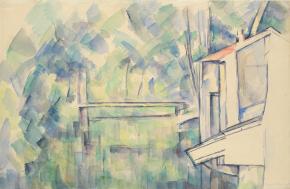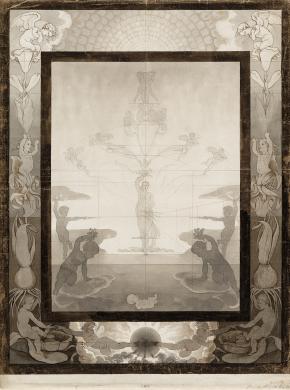
Prints and Drawings
The Kupferstichkabinett – the Kunsthalle’s department of prints and drawings – opened in 1922 in a study room designed by Fritz Schumacher, then director of Hamburg’s department of building and planning. It is located at the centre of the neoclassical limestone building planned by Alfred Lichtwark, the Kunsthalle’s first director, and opened under his successor Gustav Pauli. This outstanding collection of works on paper is one of the most important of its kind in Europe, with more than 140,000 drawings, prints and photographs in its present holdings.
A bequest by the Hamburg art dealer and collector Georg Ernst Harzen (1790–1863) formed the foundation of the collection. Harzen made a gift in perpetuity to the Hamburger Kunsthalle of some 30,000 drawings and prints, which have been housed there since 1869. A major early patron of the museum, Harzen was also a driving force behind the construction of the museum’s first building.
The Kupferstichkabinett offers a thorough survey of the evolution of European art from the 15th century to the present – and of the history of prints and drawings. Some four thousand old master drawings of the Italian, Dutch, and German schools constitute an important focus of the collection – including superb examples by the hands of such masters as Leonardo da Vinci, Raphael, Michelangelo, Canaletto, Giovanni Battista Piranesi, Rembrandt, Albrecht Dürer and Albrecht Altdorfer. Another highlight is the exceptional collection of drawings by Spanish old masters – particularly by Goya but also by the Baroque master Bartolomé Esteban Murillo. Acquired by Alfred Lichtwark in London, this group constitutes one of three major collections of its kind outside of Spain, rivalling the Louvre in Paris and the Uffizi in Florence.
The noteworthy collection of German Romantic drawings includes many fine works by Caspar David Friedrich and Philipp Otto Runge, both of whom were rediscovered by Alfred Lichtwark around 1900. The Kupferstichkabinett preserves about 90 per cent of Runge’s oeuvre. The influential art of the Nazarene movement is represented by Friedrich Overbeck and by a group of drawings by Julius Schnorr von Carolsfeld in particular. The Kupferstichkabinett also has remarkable holdings of prints, above all from Italy (15th and 17th century), Germany (16th century, including Albrecht Dürer), and the Netherlands (17th century), among which the Rembrandt etchings deserve particular emphasis. From 1886 to 1914, Lichtwark incorporated works by the peintre-graveurs – the painter-engravers working in Germany, France, and England – that were so modern at the time. This focus led to acquisitions of remarkable graphic works by Max Klinger, Félicien Rops and James McNeill Whistler, among others. Late 19th-century prints from France by Henri de Toulouse-Lautrec and others were not neglected, while the collection also brought in large groups of work by Edvard Munch, Käthe Kollwitz, Emil Nolde, Max Beckmann and such German Expressionists as Ernst Ludwig Kirchner.
The department of prints and drawings also holds several specialized collections, including 19th-century art from Hamburg (by such artists as Friedrich Wasmann, Johann Joachim Faber, Jacob, Günther and Martin Gensler, Erwin and Otto Speckter and Hermann Kauffmann); 20th-century Hamburg artists Horst Janssen (some 10,000 works) and Paul Wunderlich (ca. 500 works); and numerous print portfolios and graphic cycles. Naturally, the Kunsthalle’s extensive art library, which belongs to the Kupferstichkabinett, should also be mentioned; it maintains around 200,000 volumes, including many illustrated books as well as special editions and artists’ books with original graphic works from 1470 to the present. The archive of the personal papers of Georg Ernst Harzen – the Kupferstichkabinett’s early benefactor – is of significant interest, as is Harzen’s extensive collection of portrait prints and drawings, including many portraits of artists.
As befits a museum with a vibrant interest in contemporary art, the Kupferstichkabinett also has numerous drawings and prints by German and international contemporary artists – a field that continues to be carefully cared for and expanded. Its holdings of art photographs produced since 1960 have become quite substantial.











